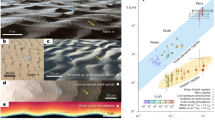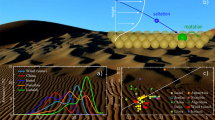Abstract
Depending on the wind regime1,2, sand dunes exhibit linear3,4, crescent-shaped or star-like forms5 resulting from the interaction between dune morphology and sand transport6,7,8. Small-scale dunes form by destabilization of the sand bed9,10,11 with a wavelength (a few tens of metres) determined by the sand transport saturation length11,12,13. The mechanisms controlling the formation of giant dunes, and in particular accounting for their typical time and length scales, have remained unknown. Using a combination of field measurements and aerodynamic calculations, we show here that the growth of aeolian giant dunes, ascribed to the nonlinear interaction between small-scale superimposed dunes4,10,14,15, is limited by the confinement of the flow within the atmospheric boundary layer16,17. Aeolian giant dunes and river dunes form by similar processes, with the thermal inversion layer that caps the convective boundary layer in the atmosphere18 acting analogously to the water surface in rivers. In both cases, the bed topography excites surface waves on the interface that in turn modify the near-bed flow velocity. This mechanism is a stabilizing process that prevents the scale of the pattern from coarsening beyond the resonant condition. Our results can explain the mean spacing of aeolian giant dunes ranging from 300 m in coastal terrestrial deserts to 3.5 km. We propose that our findings could serve as a starting point for the modelling of long-term evolution of desert landscapes under specific wind regimes.
This is a preview of subscription content, access via your institution
Access options
Subscribe to this journal
Receive 51 print issues and online access
$199.00 per year
only $3.90 per issue
Buy this article
- Purchase on Springer Link
- Instant access to full article PDF
Prices may be subject to local taxes which are calculated during checkout




Similar content being viewed by others
References
Fryberger, S. G. & Dean, G. in A Study of Global Sand Seas (ed. McKee, E. D.) 137–169 (Geological Survey Professional Paper 1052, 1979)
Werner, B. T. Eolian dunes; computer simulations and attractor interpretation. Geology 23, 1107–1110 (1995)
Tsoar, H. Dynamic processes acting on a longitudinal (seif) sand dune. Sedimentology 30, 567–578 (1983)
Bristow, C. S., Bailey, S. D. & Lancaster, N. The sedimentary structure of linear sand dunes. Nature 406, 56–59 (2000)
Lancaster, N. The dynamics of star dunes: an example from Gran Desierto, Mexico. Sedimentology 36, 273–289 (1989)
Andreotti, B., Claudin, P. & Douady, S. Selection of dune shapes and velocities. Part 1: Dynamics of sand, wind and barchans. Eur. Phys. J. B 28, 321–339 (2002)
Wiggs, G. F. S., Livingstone, I. & Warren, A. The role of streamline curvature in sand dune dynamics: evidence from field and wind tunnel measurements. Geomorphology 17, 29–46 (1996)
Lancaster, N., Nickling, W. G., McKenna-Neuman, C. K. & Wyatt, V. E. Sediment flux and airflow on the stoss slope of a barchan dune. Geomorphology 17, 55–62 (1996)
Andreotti, B., Claudin, P. & Douady, S. Selection of dune shapes and velocities. Part 2. Eur. Phys. J. B 28, 341–352 (2002)
Elbelrhiti, H., Claudin, P. & Andreotti, B. Field evidence for surface-wave-induced instability of sand dunes. Nature 437, 720–723 (2005)
Claudin, P. & Andreotti, B. A scaling law for aeolian dunes on Mars, Venus, Earth, and for subaqueous ripples. Earth Planet. Sci. Lett. 252, 30–44 (2006)
Kroy, K., Sauermann, G. & Herrmann, H. Minimal model for sand dunes. Phys. Rev. Lett. 88, 054301 (2002)
Hersen, P., Douady, S. & Andreotti, B. Relevant length scale of barchan dunes. Phys. Rev. Lett. 89, 264301 (2002)
Bristow, C. S., Duller, G. A. T. & Lancaster, N. Age and dynamics of linear dunes in the Namib desert. Geology 35, 555–558 (2007)
Kocurek, G., Havholm, K. G., Deynoux, M. & Blakey, R. C. Amalgamated accumulations resulting from climatic and eustatic changes, Akchar Erg, Mauritania. Sedimentology 38, 751–772 (1991)
Wilson, I. G. Aeolian bedforms—their development and origins. Sedimentology 19, 173–210 (1972)
Hanna, S. R. The formation of longitudinal sand dunes by large helical eddies in the atmosphere. J. Appl. Meteorol. 8, 874–883 (1969)
Stull, R. B. An Introduction to Boundary Layer Meteorology Ch. 1, 11 (Kluwer Academic, 1988)
Lancaster, N. The development of large aeolian bedforms. Sedim. Geol. 55, 69–89 (1988)
Ewing, R. C., Kocurek, G. & Lake, L. W. Pattern analysis of dune-field parameters. Earth Surf. Processes Landforms 31, 1176–1191 (2006)
Wurtele, M. G., Sharman, R. D. & Datta, A. Atmospheric lee waves. Annu. Rev. Fluid Mech. 28, 429–476 (1996)
Baddock, M. C., Livingstone, I. & Wiggs, G. F. S. The geomorphological significance of airflow patterns in transverse dune interdunes. Geomorphology 87, 322–336 (2007)
Parteli, E. J. R., Schwämmle, V., Herrmann, H. J., Monteiro, L. H. U. & Maia, L. P. Profile measurement and simulation of a transverse dune field in the Lençóis Maranhenses. Geomorphology 81, 29–42 (2006)
Andersen, K. H., Chabanol, M.-L. & van Hecke, M. Dynamical models for sand ripples beneath surface waves. Phys. Rev. E 63, 066308 (2001)
Politi, P. & Misbah, C. When does coarsening occur in the dynamics of one-dimensional fronts? Phys. Rev. Lett. 92, 090601 (2004)
Best, J. The fluid dynamics of river dunes: a review and some future directions. J. Geophys. Res. 100, F04S02 (2005)
Raudkivi, A. J. Transition from ripples to dunes. J. Hydraul. Eng. 132, 1316–1320 (2006)
Tokano, T., Ferri, F., Colombatti, G., Mäkinen, T. & Fulchignoni, M. Titan's planetary boundary layer structure at the Huygens landing site. J. Geophys. Res. 111, E08007 (2006)
Savijärvi, H., Määttänen, A., Kauhanen, J. & Harri, A. M. Mars Pathfinder: New data and new model simulations. Q. J. R. Meteorol. Soc. 130, 669–683 (2004)
Lorenz, R. D. et al. The sand seas of Titan: Cassini RADAR observations of longitudinal dunes. Science 312, 724–727 (2006)
Acknowledgements
We thank R. Littlewood for discussions and assistance with the field work. This study was supported by an ANR grant.
Author information
Authors and Affiliations
Corresponding author
Supplementary information
Supplementary Information
This file contains Supplementary Methods, Supplementary Data, Supplementary Figures 5-32 with Legends, Supplementary Tables 1-2 and Supplementary References. (PDF 2481 kb)
Rights and permissions
About this article
Cite this article
Andreotti, B., Fourrière, A., Ould-Kaddour, F. et al. Giant aeolian dune size determined by the average depth of the atmospheric boundary layer. Nature 457, 1120–1123 (2009). https://doi.org/10.1038/nature07787
Received:
Accepted:
Issue Date:
DOI: https://doi.org/10.1038/nature07787
This article is cited by
-
Coevolving aerodynamic and impact ripples on Earth
Nature Geoscience (2024)
-
What sets aeolian dune height?
Nature Communications (2022)
-
Large-Eddy Simulation of the Atmospheric Boundary Layer with Near-Wall Resolved Turbulence
Boundary-Layer Meteorology (2022)
-
Soil moisture signature in global weather balloon soundings
npj Climate and Atmospheric Science (2021)
-
A unified model of ripples and dunes in water and planetary environments
Nature Geoscience (2019)
Comments
By submitting a comment you agree to abide by our Terms and Community Guidelines. If you find something abusive or that does not comply with our terms or guidelines please flag it as inappropriate.



